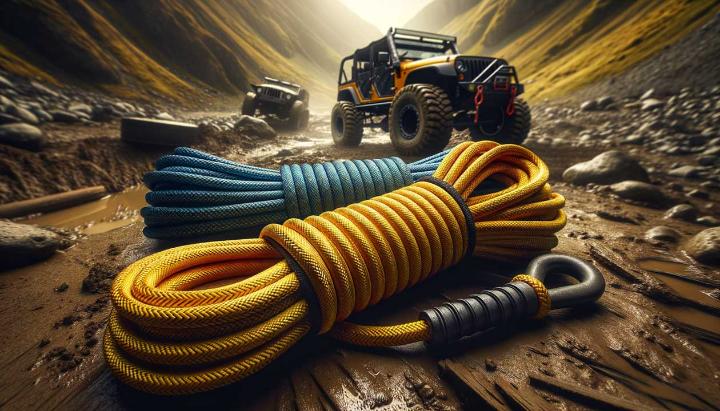Imagine this: you're deep in the outback, miles away from civilization, when your off-road vehicle gets stuck in a treacherous bog. You've tried rocking it back and forth, digging out the wheels, even letting air out of the tires – but nothing seems to work. That's when you reach for your trusty recovery rope, a specialized tool designed to help pull you out of even the stickiest situations.
But here's the dilemma – do you opt for a nylon kinetic recovery rope or a polyester towing rope? Both materials have their unique strengths and advantages, and the decision you make could mean the difference between a smooth extraction and a frustrating setback.
In this comprehensive guide, we'll dive deep into the world of recovery ropes, exploring the key characteristics of nylon and polyester fibers. From their elasticity and stretch resistance to their durability and environmental resilience, we'll uncover the strengths that make each material shine in various off-road scenarios. Whether you're a seasoned adventurer or a weekend warrior, this guide will equip you with the knowledge you need to make an informed choice and emerge victorious from even the toughest recovery situations.
Understanding the Key Characteristics of Nylon Kinetic Recovery Ropes
Have you ever found yourself in a hairy situation off-road, your vehicle stuck in mud or sand, with no way out? That's where kinetic recovery ropes, also known as snatch ropes or yanker ropes, come to the rescue. These specialized ropes are designed to stretch and absorb energy during vehicle recoveries, making the process smoother and safer for both vehicles involved.
What is a Kinetic Recovery Rope?
At their core, nylon kinetic recovery ropes are constructed with heavy-duty, double-braided nylon and feature an inner elastic core. This unique design allows them to stretch up to 30-50% more than regular snatch straps, significantly reducing the impact forces during recovery.
When it comes to strength, these ropes pack a punch. Their breaking strength should be 2-3 times the gross weight of your vehicle, ensuring they can handle even the toughest recovery situations.

Key Features and Benefits of Nylon Kinetic Recovery Ropes
- Reduced impact forces: The stretchy nature of these ropes minimizes the initial shock during recovery, making the process smoother and reducing the risk of damage to both vehicles.
- Longer lifespan: Compared to regular snatch straps, nylon kinetic recovery ropes are built to last, thanks to their durable construction and resistance to abrasion and UV damage.
- Versatility: Their stretchiness allows smaller vehicles to safely recover larger ones, expanding the range of recovery scenarios where they can be used effectively.
- Visibility and safety: Many nylon kinetic recovery ropes feature high-visibility coatings or protective sleeves, enhancing visibility and safety during recoveries.
So, the next time you find yourself in a sticky situation off-road, remember that a high-quality nylon kinetic recovery rope can be your trusty companion, ensuring a smoother and safer recovery experience.
Exploring the Versatility of Polyester Towing Ropes
When it comes to versatile towing ropes, polyester is a material that stands out from the crowd. These synthetic fiber ropes are widely used across various industries, from towing and recovery operations to mooring and rigging applications. But what makes polyester towing ropes so special? Let's dive in and explore their unique features.
Key Features of Polyester Towing Ropes
- High strength-to-weight ratio: Polyester ropes are incredibly strong yet lightweight, making them easy to handle and maneuver during towing operations.
- Abrasion resistance: With their tightly-woven construction, polyester towing ropes can withstand heavy use and resist abrasion, ensuring a longer lifespan and increased durability.
- UV and chemical resistance: Polyester fibers are naturally resistant to UV rays, moisture, and many chemicals, making these ropes ideal for outdoor use and harsh environments.
- Minimal stretch and recoil: Unlike nylon ropes, polyester towing ropes have minimal stretch and recoil, providing a more controlled towing experience and reducing the risk of sudden shocks or accidents.

Advantages of Polyester Towing Ropes over Nylon
While nylon kinetic recovery ropes offer excellent stretchability, polyester towing ropes have their own set of advantages that make them a preferred choice in certain situations. For starters, polyester ropes boast superior resistance to abrasion, UV rays, and chemicals, ensuring longer-lasting durability and performance in challenging outdoor environments.
Additionally, the minimal stretch and recoil properties of polyester ropes make them safer for towing applications, especially in scenarios where controlled and precise extractions are required. Imagine having to tow a heavy piece of equipment out of tricky terrain – a polyester towing rope can provide the stability and control you need to get the job done safely and efficiently.
In situations where extreme durability and resistance to harsh conditions are paramount, polyester towing ropes can outshine their nylon counterparts. Whether you're towing a boat through choppy waters or recovering a vehicle from a rugged off-road trail, polyester ropes can handle the challenge with ease. Interested in more robust rope solutions? Check out our elasticated cord rope structures.
Comparing Nylon and Polyester Ropes - Strengths and Advantages
When it comes to choosing the right rope for your off-road recovery needs, the decision often comes down to two main materials: nylon and polyester. Both of these synthetic fibers have their unique strengths and advantages, and understanding their differences can help you make an informed choice that best suits your specific recovery situations.
Key Differences Between Nylon and Polyester Ropes
- Elasticity and stretch resistance: Nylon ropes are known for their superior elasticity, allowing them to stretch up to 30-50% more than regular straps. This stretchability helps absorb shock and reduce impact forces during vehicle recoveries. In contrast, polyester ropes have minimal stretch, providing a more controlled and stable towing experience.
- Shock absorption and dynamic use: Due to their elasticity, nylon ropes excel in dynamic applications where shock absorption is crucial, such as climbing, rescue operations, and vehicle recoveries. Polyester ropes, on the other hand, are better suited for static applications where minimal stretch is desired, like mooring and rigging.
- Environmental resistance: Polyester ropes boast excellent resistance to UV rays, moisture, and chemicals, making them ideal for outdoor use and harsh environments. While nylon ropes are also durable, they may degrade faster when exposed to prolonged UV radiation or certain chemicals.

Applications and Use Cases for Nylon and Polyester Ropes
Nylon kinetic recovery ropes truly shine when it comes to dynamic, high-energy applications that require shock absorption and stretch resistance. Can you imagine recovering a heavily loaded off-road vehicle from a muddy bog without the forgiving elasticity of a nylon rope? The sudden shock could cause serious damage to both vehicles and potentially put you in harm's way.
On the other hand, polyester towing ropes are the go-to choice for more controlled and precise towing operations, where minimal stretch is preferred. Picture this: you're towing a heavy piece of machinery across rough terrain, and the last thing you need is a rope that stretches and bounces unpredictably. A polyester rope's minimal stretch ensures a smooth, stable towing experience, allowing you to maneuver the load with confidence and precision.
Of course, the decision between nylon and polyester ropes also depends on the specific recovery situation and environment you find yourself in. If you frequently navigate harsh outdoor conditions, a polyester rope's resistance to UV rays, moisture, and chemicals could be a game-changer. But if your recovery needs lean more towards the occasional muddy trail or sandy beach, a trusty nylon rope could be your best ally.
Remember, at the end of the day, the key is to choose the rope that best suits your unique recovery scenarios, vehicle weight, and personal preferences. With a deep understanding of the strengths and advantages of both nylon and polyester ropes, you'll be better equipped to make an informed decision and ensure a smooth, safe, and successful recovery every time. For additional insights on rope applications, you may want to explore our guide on nylon mason line.
Choosing Between Nylon and Polyester for Recovery Kinetic Ropes
When it comes to tackling rugged off-road adventures, having the right recovery gear can mean the difference between a successful extraction and a frustrating setback. Among the essential tools in any off-roader's arsenal are kinetic recovery ropes, designed to stretch and absorb the immense forces involved in vehicle recoveries. But with nylon and polyester as the two main materials used in these specialized ropes, which one should you choose?
Comparing Nylon and Polyester Properties
Let's start by examining the distinct characteristics of nylon and polyester ropes. Nylon kinetic recovery ropes are renowned for their exceptional elasticity and stretch capabilities. Imagine being stuck in a deep mud bog, with your truck's wheels spinning helplessly. In such a scenario, the stretchy nature of a nylon rope can be a lifesaver, gradually transferring the recovery force and minimizing the risk of sudden shocks or breakages.
On the other hand, polyester towing ropes offer unparalleled durability and resistance to various elements. These tough ropes can withstand harsh outdoor conditions, shrugging off moisture, chemicals, and even UV radiation with ease. Their minimal stretch property makes them ideal for controlled towing operations, where precision and stability are paramount.

Factors to Consider When Selecting a Recovery Rope
Now that you understand the fundamental differences between nylon and polyester ropes, it's time to consider the factors that should guide your decision. First and foremost, think about the specific recovery situation and environment you'll be facing. Are you tackling deep mud, loose sand, or rocky terrain? The conditions you'll encounter can significantly influence the rope's performance and durability.
Next, consider the weight and towing capacity of your vehicle. A heavier rig may require a rope with greater breaking strength, which could sway your choice towards a polyester option. Additionally, your personal preferences and budget should play a role in your selection. Some off-roaders prefer the peace of mind that comes with a stretchy nylon rope, while others prioritize the no-nonsense durability of polyester.
Ultimately, there's no one-size-fits-all solution when it comes to choosing between nylon and polyester recovery kinetic ropes. It's about finding the perfect balance between elasticity, strength, and environmental resistance to suit your unique off-road adventures. Don't be afraid to seek advice from experienced off-roaders or recovery professionals – their real-world insights can be invaluable in helping you make the right choice. If you want to learn more about high-performance rope options, you may find our article on nylon pull ropes insightful.
Deciding between a nylon kinetic recovery rope and a polyester towing rope requires understanding their distinct features and strengths. Nylon ropes are renowned for their superior elasticity, stretching up to 30-50% to absorb shocks and reduce impact forces, making them ideal for off-road recoveries. These ropes are also durable, resistant to abrasion, and UV damage. Conversely, polyester ropes offer minimal stretch, providing controlled and stable towing, with excellent resistance to chemicals, moisture, and varying temperatures. For off-road enthusiasts, selecting the right 2 kinetic recovery rope depends on the specific recovery scenario, vehicle weight, and personal preference. Evaluate the key characteristics and benefits of each material to make an informed choice that suits your recovery needs and budget.
Get Expert Advice on the Right Recovery Rope for You!
If you have any questions or need personalised assistance in choosing between nylon and polyester recovery kinetic ropes, please fill in the form above. Our experts are ready to help you find the perfect solution for your off-road recovery needs.